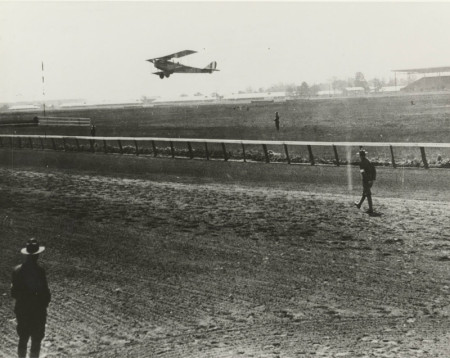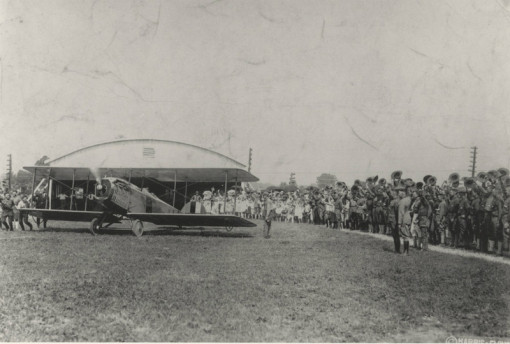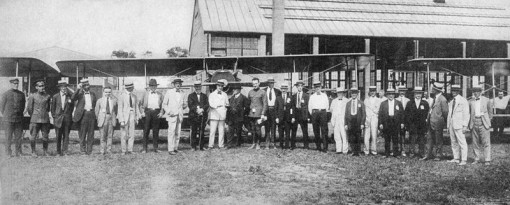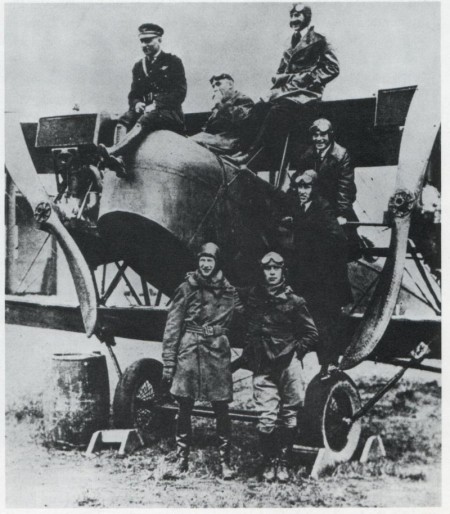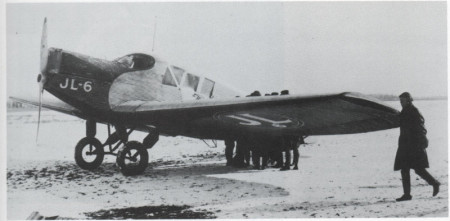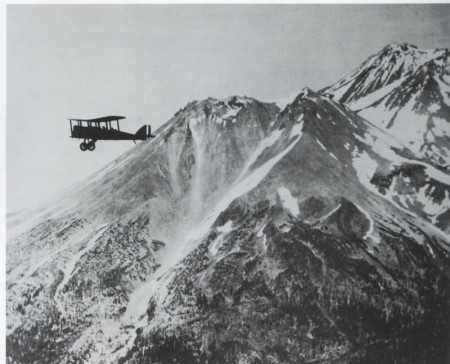
The Belmont Park Race Track on Long Island was the northern terminus of the U.S. Air Mail Service, with other stops at Philadelphia Bustleton and College Park, MD. August Belmont II, a major in the Army Quartermaster Corps, let the airmail service use his raceway for free. Here, Lt. Torrey Webb pilots a Jenny out of Belmont on the southbound run to Philadelphia.
Hats off to Max Miller as he pilots his Standard JR-1B mail plane on the first civilian airmail flight from College Park, Maryland, to Bustleton field outside Philadelphia, on August 18, 1918. The U.S. Army ended its airmail operations the week prior, and this was the America’s first-ever civilian airmail flight.
Straw skimmers make a strong showing on August 6, 1918, at the Standard Aircraft Corp. factory in Elizabeth, New Jersey, when postal officials took delivery of their first new-production aircraft. Second Assistant Postmaster General Otto Praeger is at center, flanked on the left by Standard president Harry Mingle in the white suit and on the right by Benjamin Lipsner, the first civilian superintendent of the airmail service. Other notables include: arctic explorer Capt. Robert Bartlett (far left); WWI fighter ace Capt. Frederick Libby (second from left); and Henry Woodhouse (fifth from left), editor and publisher of Aerial Age magazine.
The post office began flying between Chicago and Minneapolis in late 1920 with twin-engine de Havilland biplanes that could carry an enormous amount of mail. Here, seven pilots on the route—including Ham Lee perched on the nose—pose with a DH at the Minneapolis Speedway.
With their all-metal construction, enclosed cockpit and single wing, postal officials thought the Junkers JL 6 would be the answer to many of their operational and maintenance problems. However, a faulty fuel system led to in-flight fires and the death of several pilots, including the civilian airmail service's first and most famous pilot, Max Miller.
Otto Praeger’s transcontinental push westward required pilots and de Havillands to cross several mountain ranges, including 10,000-foot peaks of the Rocky Mountains.
Mavericks of the Sky draws on exhaustive research of new archival material to bring forward this unforgettable story of adventure, heroism and suspense set against the threshold of the Jazz Age. It was a dangerous time for mail pilots; fully one-quarter of the pilots died while trying to push the limits of flight to the extreme. Yet, still they signed on in droves—these ex-barnstormers, racecar drivers and WWI flying aces who willingly risked their lives in order to continue their obsession with flying.
Nicknamed “The Suicide Club,” the men of the U.S. Air Mail Service were an amalgam of brazen, headstrong aviators bent on defying the odds. Climbing into their flimsy wood and cloth-covered biplanes they moved the mail through torrential rain and blinding snowstorms, relying on their wits and instincts to keep them out of trouble.
They were constantly driven by tough-talking Second Assistant Postmaster General Otto Praeger—a gritty newspaperman who along with his boss Albert Burleson, the tenacious postmaster general in the cabinet of President Woodrow Wilson, held a common faith in the future of aviation.
Despite the deaths, the public skepticism and the contempt in which Congress held airmail, Praeger and Burleson refused to give up. Day after day, they held to the same impossible conviction—that airmail could be reliable and eventually far superior to rail service. To prove their point, mail pilots were ordered to maintain strict timetables through the cruelest of weather conditions, creating a bitter clash of wills between postal officials and the group-proud pilots who chafed under their vice-like dictums and policies.
Yet together, this battling group of visionaries left behind an undeniable legacy, both to modern aviation and to the world. Just three years after the first inaugural flight, the U.S. Post Office Department succeeded in expanding airmail westward, ultimately connecting the entire county by air, from New York to San Francisco, establishing the first reliable application of powered flight for civilian use.
Rosenberg and Macaulay unfold the lives and exploits of these unlikely American heroes in a narrative that is as irresistibly fascinating as its subject—revealing the underpinnings of the American pioneer spirit.
Hardcover published by William Morrow, paperback published by Harper Perennial, with Kindle version also available.
